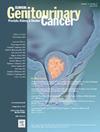Diagnosis, Treatment and Survival From Testicular Cancer: Real-World Data From the National Health Service England Between 2013 and 2020
IF 2.7
3区 医学
Q3 ONCOLOGY
引用次数: 0
Abstract
Introduction
The National Disease Registration Service (NDRS) collects and curates data on cancer diagnoses in England. This study analyzed testicular cancer (TC) data from 2013 to 2020.
Patient and Methods
Data were extracted from the NDRS “Get Data Out” database. The incidence per year, routes to diagnosis (RTD), treatment modalities and overall survival were analyzed.
Results
Between 2013 to 2020, 15,921 TC were diagnosed. The majority of cases were seminomatous germ cell tumors (SGCT) (61.4%), followed by nonseminomatous germ cell tumors (NSGCT) (33.6%). The annual incidence remained relatively stable, with 2010 cases in 2013 and 2023 cases in 2019. The majority of patients were ≥30 years (72.4%). Most cases (64%) were diagnosed with stage I disease, with a rising incidence observed in stage I NSGCTs. The primary RTD was the 2-week-wait (2ww) cancer pathway (59.1%), followed by GP referrals (15.7%) and emergency presentations (8.9%). A total of 90.4% of TC were treated with surgery, with or without chemotherapy, regardless of the histological subtype. Stage II-III disease more commonly underwent surgery combined with chemotherapy compared to stage I disease (65.7% vs. 46.8%, P < .0001). The 12, 24, and 60-month survival was 98.0%, 96.9%, and 95.6% respectively. Stage I disease and SGCT were associated with better survival outcomes (P < .001). Missing data from this dataset is a limitation.
Conclusion
The incidence of TC in England is relatively stable. Most TC were diagnosed via the 2ww cancer pathway. Surgery was the primary treatment modality and survival rates have remained relatively stable over time. Real-world data provide a cost-effective, time-efficient source of information to guide disease epidemiology, diagnostics, treatments, and outcomes.
睾丸癌的诊断、治疗和生存:2013年至2020年英国国民健康服务的真实世界数据。
简介:国家疾病登记服务(NDRS)收集和管理英国癌症诊断的数据。这项研究分析了2013年至2020年睾丸癌(TC)的数据。患者和方法:数据从NDRS“Get Data Out”数据库中提取。分析年发病率、诊断途径(RTD)、治疗方式和总生存期。结果:2013 - 2020年确诊TC 15921例。以半瘤性生殖细胞肿瘤(SGCT)居多(61.4%),其次为非半瘤性生殖细胞肿瘤(NSGCT)(33.6%)。年发病率保持相对稳定,2013年为2010例,2019年为2023例。大多数患者年龄≥30岁(72.4%)。大多数病例(64%)被诊断为I期疾病,在I期nsgct中观察到发病率上升。主要的RTD是2周等待(2w)癌症途径(59.1%),其次是全科医生转诊(15.7%)和急诊(8.9%)。无论组织学亚型如何,总共90.4%的TC接受了手术治疗,有或没有化疗。与I期疾病相比,II-III期疾病更常接受手术联合化疗(65.7%比46.8%,P < 0.0001)。12、24和60个月生存率分别为98.0%、96.9%和95.6%。I期疾病和SGCT与更好的生存结果相关(P < 0.001)。这个数据集中缺少数据是一个限制。结论:TC在英国的发病率相对稳定。大多数TC是通过2ww癌症途径诊断的。手术是主要的治疗方式,生存率一直保持相对稳定。真实世界的数据为指导疾病流行病学、诊断、治疗和结果提供了具有成本效益和时间效率的信息来源。
本文章由计算机程序翻译,如有差异,请以英文原文为准。
求助全文
约1分钟内获得全文
求助全文
来源期刊

Clinical genitourinary cancer
医学-泌尿学与肾脏学
CiteScore
5.20
自引率
6.20%
发文量
201
审稿时长
54 days
期刊介绍:
Clinical Genitourinary Cancer is a peer-reviewed journal that publishes original articles describing various aspects of clinical and translational research in genitourinary cancers. Clinical Genitourinary Cancer is devoted to articles on detection, diagnosis, prevention, and treatment of genitourinary cancers. The main emphasis is on recent scientific developments in all areas related to genitourinary malignancies. Specific areas of interest include clinical research and mechanistic approaches; drug sensitivity and resistance; gene and antisense therapy; pathology, markers, and prognostic indicators; chemoprevention strategies; multimodality therapy; and integration of various approaches.
 求助内容:
求助内容: 应助结果提醒方式:
应助结果提醒方式:


